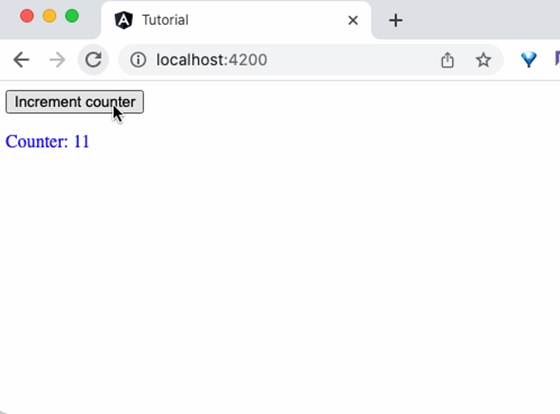
- Angular 教程
- Angular - 首頁
- Angular - 概述
- Angular - 功能
- Angular - 優點與缺點
- Angular 基礎
- Angular - 環境搭建
- Angular - 第一個應用
- Angular - MVC 架構
- Angular 元件
- Angular - 元件
- Angular - 元件生命週期
- Angular - 檢視封裝
- Angular - 元件互動
- Angular - 元件樣式
- Angular - 巢狀元件
- Angular - 內容投影
- Angular - 動態元件
- Angular - 元素
- Angular 模板
- Angular - 模板
- Angular - 文字插值
- Angular - 模板語句
- Angular - 模板中的變數
- Angular - SVG 作為模板
- Angular 資料繫結
- Angular - 資料繫結及其型別
- Angular - 資料繫結
- Angular - 事件繫結
- Angular - 屬性繫結
- Angular - 屬性繫結
- Angular - 類和樣式繫結
- Angular 指令
- Angular - 指令
- Angular - 內建指令
- Angular 管道
- Angular - 管道
- Angular - 使用管道轉換資料
- Angular 依賴注入
- Angular - 依賴注入
- Angular HTTP 客戶端程式設計
- Angular - 服務
- Angular - HTTP 客戶端
- Angular - 請求
- Angular - 響應
- Angular - GET 請求
- Angular - PUT 請求
- Angular - DELETE 請求
- Angular - JSON-P
- Angular - 使用 HTTP 進行 CRUD 操作
- Angular 路由
- Angular - 路由
- Angular - 導航
- Angular - Angular Material
- Angular 動畫
- Angular - 動畫
- Angular 表單
- Angular - 表單
- Angular - 表單驗證
- Angular Service Workers & PWA
- Angular - Service Workers & PWA
- Angular 測試
- Angular - 測試概述
- Angular NgModule
- Angular - 模組介紹
- Angular 高階
- Angular - 身份驗證與授權
- Angular - 國際化
- Angular - 可訪問性
- Angular - Web Workers
- Angular - 伺服器端渲染
- Angular - Ivy 編譯器
- Angular - 使用 Bazel 構建
- Angular - 向後相容性
- Angular - 響應式程式設計
- Angular - 指令和元件之間的資料共享
- Angular 工具
- Angular - CLI
- Angular 其他
- Angular - 第三方控制元件
- Angular - 配置
- Angular - 資料顯示
- Angular - 裝飾器和元資料
- Angular - 基本示例
- Angular - 錯誤處理
- Angular - 測試和專案構建
- Angular - 生命週期鉤子
- Angular - 使用者輸入
- Angular - 新特性?
- Angular 有用資源
- Angular - 快速指南
- Angular - 有用資源
- Angular - 討論
子元件與父元件之間的資料共享
Angular 提供了在父元件和子元件之間傳遞資料的方法。Angular 提供了兩個裝飾器,@Input 和 @Output。Input 裝飾器使用子元件屬性將值從父元件傳遞到子元件。Output 裝飾器使用子元件發出的事件將值從子元件傳遞到父元件。父元件必須監聽來自子元件的更改事件,捕獲事件資訊並使用它。
讓我們在本節學習如何使用 Input 和 Output 裝飾器。
@Input
配置 Input 裝飾器非常簡單。只需將 Input 裝飾器附加到子元件中的屬性,然後透過子元件屬性從父元件傳遞資料。
假設我們想將計數器從父元件傳遞到子元件。
步驟1:在子元件中建立一個名為 counter 的屬性,並用 @Input 裝飾它。
@Input() counter: number = 0;
這裡:
@Input() 是裝飾器
counter 是輸入屬性
number 是輸入屬性的資料型別,它是可選的
0 是計數器的初始值。如果沒有提供輸入,將使用此值。
步驟2:在父元件中初始化一個變數,例如 counterValue。
counterValue: number = 10
步驟3:使用子元件屬性 (counter) 從父元件傳遞 counter 輸入。
<app-child-component [counter]="counterValue" />
步驟4:最後,根據需要在子元件模板中使用 counter 值。
counter: {{counter}}
讓我們建立兩個元件,父元件和子元件,然後嘗試將資料從父元件傳遞到子元件並在子元件中渲染它。
步驟1:使用 Angular CLI 建立父元件 InOutSample,如下所示:
$ ng generate component InOutSample CREATE src/app/in-out-sample/in-out-sample.component.css (0 bytes) CREATE src/app/in-out-sample/in-out-sample.component.html (28 bytes) CREATE src/app/in-out-sample/in-out-sample.component.spec.ts (596 bytes) CREATE src/app/in-out-sample/in-out-sample.component.ts (228 bytes) UPDATE src/app/app.module.ts (1289 bytes)
步驟2:在元件中新增一個 counter 變數,如下所示:
import { Component } from '@angular/core';
@Component({
selector: 'app-in-out-sample',
templateUrl: './in-out-sample.component.html',
styleUrls: ['./in-out-sample.component.css']
})
export class InOutSampleComponent {
counter: number = 10;
}
步驟3:使用 Angular CLI 建立一個新的子元件 InOutChildSample,如下所示:
$ ng generate component InOutChildSample CREATE src/app/in-out-child-sample/in-out-child-sample.component.css (0 bytes) CREATE src/app/in-out-child-sample/in-out-child-sample.component.html (34 bytes) CREATE src/app/in-out-child-sample/in-out-child-sample.component.spec.ts (632 bytes) CREATE src/app/in-out-child-sample/in-out-child-sample.component.ts (251 bytes) UPDATE src/app/app.module.ts (1417 bytes)
步驟4:在子元件中新增一個 counter 屬性,並用 @Input() 裝飾器裝飾它,如下所示:
import { Component, Input } from '@angular/core';
@Component({
selector: 'app-in-out-child-sample',
templateUrl: './in-out-child-sample.component.html',
styleUrls: ['./in-out-child-sample.component.css']
})
export class InOutChildSampleComponent {
@Input() counter : number = 0;
}
步驟5:開啟子元件模板 in-out-child-sample.component.html 並使用 counter 屬性,如下所示:
<div>
<p>Counter: {{counter}}</p>
</div>
步驟6:開啟父元件模板 in-out-sample.component.html 並渲染子元件以及 counter 屬性,如下所示:
<app-in-out-child-sample [counter]="counter" />
步驟7:開啟 app 元件的模板並渲染父元件,如下所示:
<app-in-out-sample /> <router-outlet></router-outlet>
步驟8:最後,執行應用程式並檢查計數器是否顯示從父元件傳遞的值,如下所示:

讓我們嘗試使用按鈕和點選事件更改父元件中的 counter 變數,然後檢視它是否會影響子元件。
步驟1:在父元件中新增一個函式來遞增 counter 值,如下所示
inc() {
this.counter++
}
步驟2:在父元件的模板中新增一個按鈕並繫結該函式,如下所示:
<button (click)="inc()">Increment counter</button> <app-in-out-child-sample [counter]="counter" />
步驟3:最後,執行應用程式並檢查父元件中變數的更改是否反映在子元件中。

@Output
Output 裝飾器與 Input 裝飾器非常相似,只是輸出實際上是一個事件發射器,它與事件一起傳遞資料(輸出)。父元件可以訂閱子元件中的事件,並在子元件中資料更改時從子元件獲取發射的值。
步驟1:透過使用 Output 裝飾器建立子元件中的事件發射器。
@Output() counterEvent = new EventEmitter<number>();
步驟2:當子元件中的資料發生更改時發出 counter 事件。
this.counterEvent.emit(changedValue)
步驟3:在父元件中捕獲事件並從回撥函式中獲取資料。
<parent-component (counterEvent)="get($event)" />
步驟4:在父元件中對捕獲的值執行任何操作。
讓我們在子元件 InOutChildSample 元件中編寫一個 Output 裝飾器,並嘗試從父元件 InOutSample 元件獲取輸出。
步驟1:在子元件 in-out-child-sample.component.ts 中建立一個輸出事件發射器,如下所示:
@Output() counterEvent = new EventEmitter<number>();
步驟2:建立一個方法,透過在子元件 in-out-child-sample.component.ts 中發射事件以及 counter 資料來傳遞 counter 的值
passCounterToParent() {
this.counterEvent.emit(this.counter)
}
子元件的完整列表如下:
import { Component, Input, Output, EventEmitter } from '@angular/core';
@Component({
selector: 'app-in-out-child-sample',
templateUrl: './in-out-child-sample.component.html',
styleUrls: ['./in-out-child-sample.component.css']
})
export class InOutChildSampleComponent {
@Input() counter : number = 0;
@Output() counterEvent = new EventEmitter<number>();
passCounterToParent() {
this.counterEvent.emit(this.counter)
}
}
步驟3:開啟子元件模板 in-out-child-sample.component.html 並新增一個按鈕,以便在使用者單擊按鈕時呼叫 counter 事件
<div>
<p>Counter: {{counter}}</p>
<button (click)="passCounterToParent()">Pass Counter to Parent</button>
</div>
這裡:
click 是按鈕點選事件,它被配置為在點選時執行 passCounterToParent() 函式。
步驟4:在父元件中新增一個變數來儲存透過子元件事件傳遞的輸出資料。
childCounter: number = 0
步驟5:在父元件中新增一個函式來獲取透過子元件事件傳遞的輸出資料。
get(val: number) {
this.childCounter = val;
}
父元件的完整列表如下:
import { Component } from '@angular/core';
@Component({
selector: 'app-in-out-sample',
templateUrl: './in-out-sample.component.html',
styleUrls: ['./in-out-sample.component.css']
})
export class InOutSampleComponent {
counter: number = 10;
childCounter: number = 0;
inc() {
this.counter++
}
get(val: number) {
this.childCounter = val;
}
}
步驟6:開啟父元件模板 in-out-sample.component.html 並訂閱子元件的事件 counterEvent 並將 get 方法設定為回撥函式,如下所示:
<button (click)="inc()">Increment counter</button>
<p>Data from child: {{childCounter}}</p>
<app-in-out-child-sample [counter]="counter" (counterEvent)="get($event)" />
這裡:
counterEvent 是來自子元件的事件
counterEvent 是回撥函式。$event 將儲存當前的 counter 值。
childContent 是來自子元件的資料
步驟7:最後,執行應用程式,您將看到當單擊子元件中的按鈕時,子元件會將更新的 counter 值傳送到父元件。

總結
Input 和 Output 裝飾器簡化了在父元件和子元件之間傳遞資料,並提供了父元件和子元件之間豐富的互動。